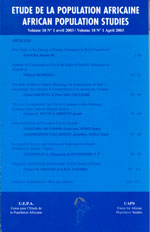
|
African Population Studies
Union for African Population Studies
ISSN: 0850-5780
Vol. 17, No. 2, 2002, pp. 1-22
|
 Bioline Code: ep02007
Bioline Code: ep02007
Full paper language: French
Document type: Research Article
Document available free of charge
|
|
|
African Population Studies, Vol. 17, No. 2, 2002, pp. 1-22
| fr |
Relations de Genre, Structures Démographiques des Ménages et Scolarisation des Jeunes au Cameroun
Wakam, Jean
Résumé
Cette étude examine comment
les ménages camerounais se comportent en matière de scolarisation des
filles et des garçons de 15-24 ans selon leur composition par sexe et par
âge, à partir des données du recensement de 1987. Il en ressort
notamment que: (1) La scolarisation est mieux assurée, et de façon moins
inégalitaire, par les ménages dirigés par des femmes (MDF) que
par ceux dirigés par des hommes (MDH), mais toujours davantage au profit
des garçons; (2) La présence et le nombre d'enfants en bas âge
affectent essentiellement la scolarisation des filles et davantage dans les MDF;
(3) Le nombre d'enfants scolarisables (filles ou garçons), notamment
célibataires, est plutôt très positivement associé, tant à
la scolarisation des filles qu'à celle des garçons et aussi bien
dans les MDH que dans les MDF et tend ainsi à infirmer la théorie de
la "quantity/quality trade-off" selon laquelle les familles ayant beaucoup
d'enfants investissent moins dans chaque enfant (capital humain) que celles
qui en ont peu; (4) La présence et le nombre de femmes adultes et âgées
tendent à favoriser systématiquement la scolarisation tant féminine
que masculine et témoigne de la "substituabilité" des femmes
et des enfants, et notamment des filles, dans l'accomplissement des tâches
domestiques. Par contre, la présence et le nombre d'hommes ne favorisent
tout au plus que la scolarisation masculine et réduisent systématiquement
celle des filles, sauf dans les MDF. Bref, les relations de genre structurent
grandement les comportements des ménages camerounais en matière de scolarisation
des enfants.
|
| |
| en |
Wakam, Jean
Abstract
This study investigates
how households in Cameroon deal with the schooling of 15-24 year old girls and
boys on the basis of sex and age distribution using the 1987 Census data. The
results obtained show that: (1) More equitable schooling opportunities for boys
and girl are available in households led by women than those headed by men, even
though there still exists a comparative preference for boys. (2) The presence
and number of 0-5 year old children is likely to reduce the schooling of girls
and particularly in households led by women; (3) The number of children (girls
and boys) of school age especially when they are bachelors, is rather very positively
correlated to the schooling of both girls and boys in households led by men as
well as by women. This tends to invalidate the theory of "quantity/quality
trade-off" which sustains that households with a lot of children invest less
in each child (human capital) than those with less children; (4) The presence
and number of adult and old women tends to encourage systematically the schooling
of boys and girls and are a proof of the "substitutability" between
women and children, specifically girls in taking up domestic works. On the contrary,
the presence and number of men only tends to encourage the schooling of male children
to the disadvantage of girls, except when the households are headed by women.
Therefore, Cameroonian households tend to make gender considerations when educating
their children.
|
| |
© Copyright 2002 - Union for African Population Studies
Alternative site location: http://www.uaps-uepa.org
|
|
